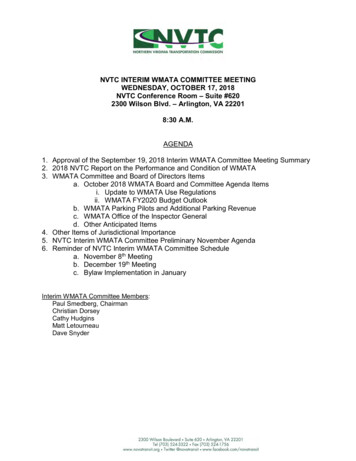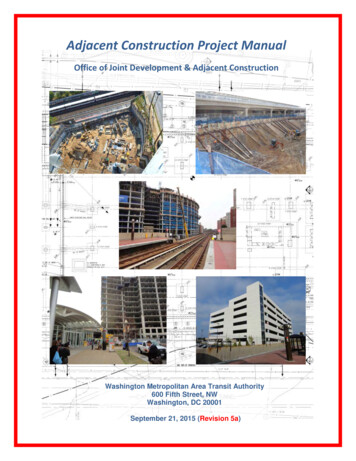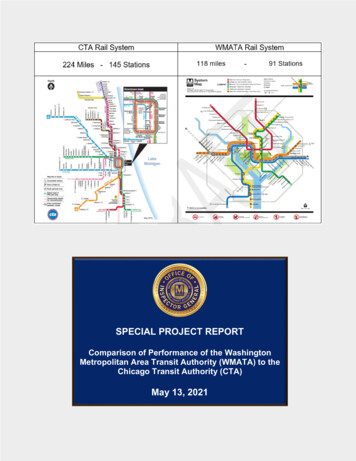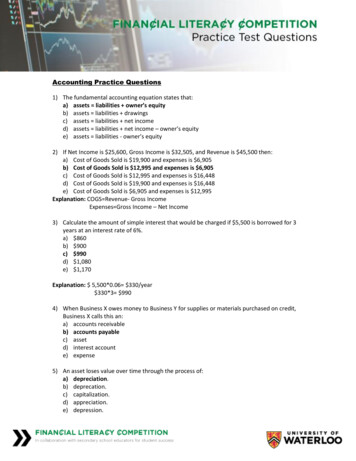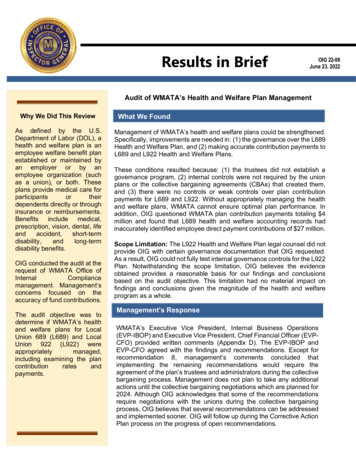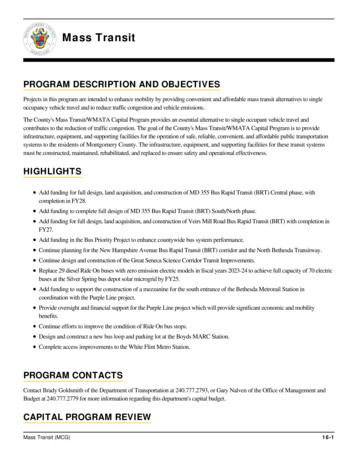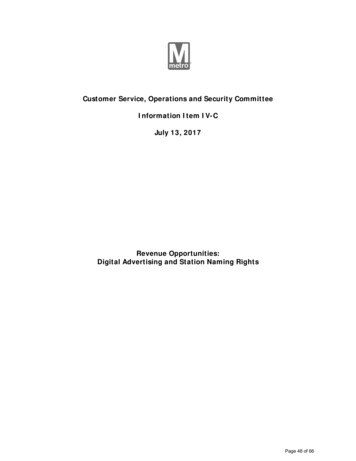
Transcription
Customer Service, Operations and Security CommitteeInformation Item IV-CJuly 13, 2017Revenue Opportunities:Digital Advertising and Station Naming RightsPage 48 of 66
Washington Metropolitan Area Transit AuthorityBoard Action/Information SummaryActionInformationMEAD Number:201892Resolution:YesNoTITLE:Digital Advertising & Station NamingPRESENTATION SUMMARY:The presentation examines opportunities to increase revenue through creative advertisinginitiatives, an expanding digital advertising program, and the possibility of selling commercialstation naming rights.PURPOSE:To update the Board on revenue opportunities through advertising initiatives, digital advertisingexpansion, and the potential sale of commercial naming rights for Metrorail stations.DESCRIPTION:Staff is pursuing opportunities to increase revenue through advertising sales. This includes anexpanded digital advertising program and other creative advertising opportunities, such asvehicle wraps and “station domination” advertising at key stations. Commercial stationnaming may present new revenue opportunities; however, existing Board policy currentlyprohibits the sale of station naming rights.Key Highlights: Overall, advertising revenue is anticipated to total nearly 24 million in FY18,comprising 1.3 percent of WMATA's annual operating budget. Overall, advertisingrevenue is anticipated to total 24 million in FY18, comprising 1.3 percent ofWMATA’s annual operating budget.The ridership decline in recent years has impacted the number of viewers ofsystem advertising, and changes to limit advertising content have adverselyimpacted advertising revenue.Digital advertising displays generate three times the revenue of traditionaldisplays.The sale of commercial station naming rights presents an opportunity for newrevenue; however the practice is not currently permitted.Background and History:Advertising Revenue OverviewThe existing advertising contract with OUTFRONT Media was awarded on JanuaryPage 49 of 66
2014 and began July 1, 2014 (FY15) as a five year base with two option years, for atotal guaranteed amount of 171 million. Additional inventory introduced with theopening of Silver Line Phase 1 increased the Minimum Annual Guarantee (MAG) by 1,548,768 each year following the Silver Line opening. The revised Minimal AnnualGuarantee for each contract year is displayed in the following table.OUTFRONT ContractYearFY 15, Base Year 1FY 16, Base Year 2FY 17, Base Year 3FY 18, Base Year 4FY 19, Base Year 5FY 20, Option Year 1FY 21, Option Year 2Revised MinimumAnnual Guarantee 19,250,000 21,298,768 21,798,768 22,548,768 23,298,768 23,798,768 24,298,768Actual OUTFRONTAdvertising Revenue 22,322,015 21,963,336 22,180,811Advertising revenue makes up just 1.3 percent of WMATA’s annual operating budget.A few factors are currently impacting advertising sales in the Metro system: The ridership decline in recent years, exacerbated by SafeTrack in 2016, hasimpacted the number of viewers of system advertising, and is affecting revenue asa resultThe policy change to eliminate advocacy advertising in the system resulted inreduced advertising revenue in FY16 and FY17, as expected. As more advertisinghas shifted to an advocacy focus post-election, revenue has been furtherimpactedWMATA’s advertising sales total for FY15 was 37,115,600 and 39,000,000 for FY16.A comparison of advertising sales for various transit agencies is displayed in thefollowing table.Transit AgencyMARTAMIAMI-DADEWMATALACMTAFY15 Advertising Sales 8,727,000 11,285,000 37,115,600 37,000,000FY16 Advertising Sales 8,177,000 11,211,000 39,000,000 41,200,000Digital Advertising ProgramEarly in 2015, WMATA moved into the arena of digital advertising with a pilot thatplaced 10 digital panels (72-inch size) in eight stations. These units were uniquebecause they not only offered a platform for digital advertising, but replaced passengerinformation in the form of Metrorail System maps and Station Area maps withtouchscreen wayfinding and system information. The units were installed in the freeareas of high volume stations. This pilot was conducted indpendent of WMATA'sadvertising partner, OUTFRONT Media.Page 50 of 66
Then, in early 2016, OUTFRONT Media began offering a digital platform, and WMATAadded a three-panel array of digital screens at Navy Yard-Ball Park station on the Halfand M Streets (Ballpark) side. Working with OUTFRONT Media and internal resources,the digital advertising network was further expanded in 2016, adding 62 additionalscreens spread out across 22 stations. Locations were strategically chosen based onrevenue potential.The replacement of static ad units with digital panels increases revenue potentialthreefold by allowing advertisers to purchase 5, 10 and 15 second “flips,” in a 90 secondloop, rather than one advertiser purchasing space for 4-week periods.In FY17, digital ads contributed a significant precentage of WMATA's 22,180,811 ofadvertising revenue.Discussion:Advertising OpportunitiesWith digital advertising generating three times the revenue of traditional displays, anaggressive digital advertising program is underway to combat other factors impactingad revenue and to create new, attractive advertising opportunities in the system.Expansion plans for Q1, FY18 include an additional 67 screens bringing another 23stations into the Digital Platform Network. Future digital plans include a Fare InformationPilot for Ronald Reagan Washington National Airport Station and Union Station iscurrently in development, with implementation anticipated in Q2, FY18. These fourscreens will add to the Digital Mezzanine Network. Silver Line Phase 2 stations andPotomac Yard Station are all planned to include completely digital platforms.WMATA is also actively in discussion about how to convert the remaining 542 back-litdioramas into digital platforms in rail stations, as well as reviewing the powerrequirements to add new inventory at stations where advertising demand is highest.In addition to digital advertising, WMATA is pursuing other creative advertisingopportunities to generate revenue.WMATA branded merchandise is currently sold online and at a number of retail outletsin the District of Columbia. Additionally, third-party licenses for umbrellas, showercurtains, canteen bottles, toy trains and buses sell Metro merchandise through Amazon,Target and Bed, Bath & Beyond. WMATA generates royalties at 10 percent of sales,with online gift store gross sales averaging approximately 50,000 annually.Train wraps are another advertising opportunity WMATA is pursuing to generaterevenue. Under WMATA’s advertising guidelines, commercial entities have theopportunity to purchase exterior rail car ads. While WMATA is not able to guaranteecertain rail lines, advertisers choose the number of rail cars to wrap. For example,McDonalds and Cirque de Soleil have completed “wrapped train” campaigns, whichconsists of two railcars fully wrapped, while Red Bull wrapped a single rail car for one ofits advertising campaigns.Page 51 of 66
The advertiser is required to pay for the vinyl full wrap of each car, installation andremoval of the ads and the space cost for one four week period. The value of trainwraps to WMATA is 68% of the space value.Finally, Station Dominations provide an opportunity for advertisers to prominentlydisplay their advertisements and generate significant revenue. According toOUTFRONT Media, “A station domination allows an advertiser to completely dominatethe consumer landscape at key, high traffic commuter centers – transformingcommuters’ daily ride into a total “brand experience,” delivering multiple campaignmessages.”Station Dominations are currently offered at 12 stations: Capitol SouthFarragut NorthFederal TriangleGallery PlaceL’Enfant PlazaMetro CenterMt Vernon SquareNavy Yard-BallparkPentagonRonald Reagan Washington National AirportTysons CornerUnion StationThe specific media and cost for a station domination varies by station, with stationdomination space costing from 60,000 to 100,000 for a given 4-week period. The onestation domination that currently sells out months in advance is Pentagon Station, whichsells at least six months at a time. Station dominations are also popular at Gallery Placeand other high traffic, transfer stations.Commercial Station Naming OpportunitiesConsistent with the General Manager's plan to Keep Metro Safe, Reliable andAffordable, staff is reviewing innovativate revenue options that would help offset thecosts of transit service. Fully leveraging our real estate assets would include examiningthe marketplace to determine the potential revenue for commercial station naming,which has generated millions of dollars in non-fare revenue for other transit properties.For example, New York City’s Metropolitan Transit Authority signed a contract with adeveloper to rename Atlantic Avenue Station as Atlantic Avenue-Barclays CenterStation. The contract is set at 200,000 per year for 20 years ( 4 million total).In Philadelphia, SEPTA reached a 5 million deal over 5 years to rename PattisonStation as AT&T Station. SEPTA also concluded a 4 million deal over 5 years with theJefferson Health System to rename Market East Station as Jefferson Station.Other transit systems have explored, but not completed, the sale of commercial namingrights for stations. In 2014, the Massachusetts Bay Transportation Authority (MBTA)Page 52 of 66
developed a Corporate Sponsorship Program and solicited interest for naming rights atnine stations and the option for firms to add their name to multiple lines. However,MBTA did not receive any proposals that met the minimum bid requirement.In 2016, the Los Angeles County Metropolitan Transportation Authority approved aCorporate Sponsorship/Naming Rights program to sell naming rights for various LAMetro assets, including stations. However, in February 2017, LA Metro repealed thepolicy due to legal concerns.WMATA staff believes there may be potential station naming opportunities for WMATAat Gallery Place, Navy Yard-Ballpark, Metro Center and L’Enfant Plaza stations due tolocation, proximity to venues and ridership density.Existing policy prohibits sale of commercial naming rights. The followingguidelines regarding commercial naming rights were incorporated into WMATA’s StationNaming Policy following passage of Board Resolution 2012-20: Continue current practice of not selling commercial naming rightsPromote station domination and other opportunities to grow revenue outside ofchanging station names.The next step in considering the sale of station naming rights is for the Committee todiscuss policy changes needed for staff to move forward with a market valuation ofcommercial station naming.FUNDING IMPACT:No impact on fundingProject Manager: Lynn BowersoxProjectCustomer Service, Communications, and Marketing (CSCM)Department/Office:TIMELINE:Previous ActionsJuly 2012: Board Resolution 2012-20 states WMATA will“continue current practice of not selling commercial namingrights.”Anticipated actions after July – October 2017: Digital Advertising expansion in MetrorailstationspresentationPage 53 of 66
Washington Metropolitan Area Transit AuthorityCommercial Revenue Opportunities:Digital Advertising andStation Naming RightsCustomer Service, Operations and Security CommitteeJuly 13, 2017Page 54 of 66
PurposeTo update the Board on commercial revenueopportunities through digital advertising and thepotential sale of station naming rightsPage 55 of 66
FY18 Revenue BreakdownPassenger Fares 713 millionAdvertising 24 millionParking Fees 42 millionNon-Passenger 90 millionJurisdictional Contribution 980 millionJoint Development 8 millionFiber Optics 16 millionOther 11 millionReimbursable 31 millionPage 56 of 66
Advertising Revenue Performance 23,000,000 22,500,000 22,000,000 21,500,000 21,000,000 20,500,000 20,000,000 19,500,000 19,000,000 18,500,000 18,000,000 17,500,000FY15FY16Minimum Annual GuaranteeFY17ActualPage 57 of 66
Advertising Sales ComparisonAgencyMARTAFY15FY16 8,727,000 8,177,000MIAMI-DADE 11,285,000 11,211,000WMATA 37,115,600 39,000,000LACMTA 37,000,000 41,200,000Page 58 of 66
Vehicle Wraps6Page 59 of 66
Digital Advertising Expansion 75 digital screens system-wide 67 additional screens expected in Q1, FY18 Working with contractor to plan next phase of digitalconversion beyond these 142 screensPage 60 of 66
Station Dominations8Page 61 of 66
Current Station Naming PolicyJuly 26, 2012 – Board Resolution 2012-20: “Continue current practice of not sellingcommercial naming rights” “Promote station domination and otheropportunities to grow revenue outside ofchanging station names”Page 62 of 66
2012 Station Naming Discussion Majority of customers opposed commercialstation naming Riders prefer brief location names that serveusers as wayfinders Concerns about brand association with historiclandmarks/icons Largely untried by other transit propertiesPage 63 of 66
Industry ExamplesPhiladelphia: 5 million over 5 yearsNew York City: 4 million over 20 yearsPhiladelphia: 4 million11over 5 yearsPage 64 of 66
Next Steps Board guidance on reconsideration of thepolicy Required for staff to explore marketpotential of naming rights revenuePage 65 of 66
The policy change to eliminate advocacy advertising in the system resulted in reduced advertising revenue in FY16 and FY17, as expected. As more advertising has shifted to an advocacy focus post-election, revenue has been further impacted WMATA's advertising sales total for FY15 was 37,115,600 and 39,000,000 for FY16.
